SNMP协议介绍
Posted lsgxeva
tags:
篇首语:本文由小常识网(cha138.com)小编为大家整理,主要介绍了SNMP协议介绍相关的知识,希望对你有一定的参考价值。
SNMP协议介绍
一、什么是SNMP
SNMP:“简单网络管理协议”,用于网络管理的协议。SNMP用于网络设备的管理。SNMP的工作方式:管理员需要向设备获取数据,所以SNMP提供了 “读”操作;管理员需要向设备执行设置操作,所以SNMP提供了“写”操作;设备需要在重要状况改变的时候,向管理员通报事件的发生,所以SNMP提供了 “Trap”操作。
二、SNMP背景
SNMP 的基本思想:为不同种类的设备、不同厂家生产的设备、不同型号的设备,定义为一个统一的接口和协议,使得管理员可以是使用统一的外观面对这些需要管理的网 络设备进行管理。通过网络,管理员可以管理位于不同物理空间的设备,从而大大提高网络管理的效率,简化网络管理员的工作。
三、SNMP结构概述
SNMP 被设计为工作在TCP/IP协议族上。SNMP基于TCP/IP协议工作,对网络中支持SNMP协议的设备进行管理。所有支持SNMP协议的设备都提供 SNMP这个统一界面,使得管理员可以使用统一的操作进行管理,而不必理会设备是什么类型、是哪个厂家生产的。如下图,
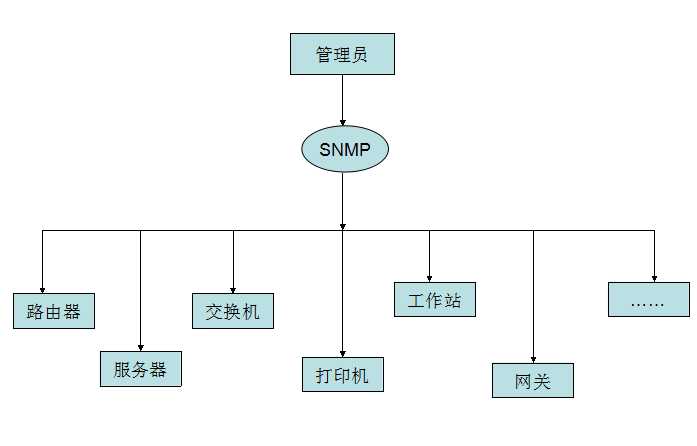
四、SNMP支持的网管操作
对于网络管理,我们面对的数据是设备的配置、参数、状态等信息,面对的操作是读取和设置;同时,因为网络设备众多,为了能及时得到设备的重要状态,还要求设备能主动地汇报重要状态,这就是报警功能。如下图,
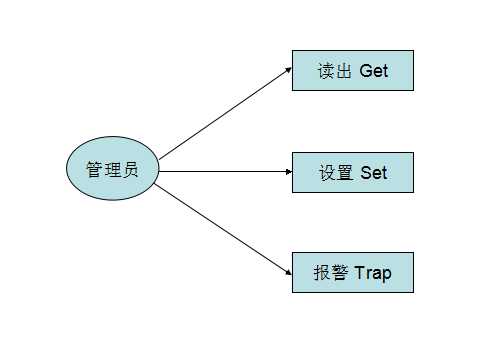
- Get:读取网络设备的状态信息。
- Set:远程配置设备参数。
- Trap:管理站及时获取设备的重要信息。
五、SNMP的实现结构
在具体实现上,SNMP为管理员提供了一个网管平台(NMS),又称为管理站,负责网管命令的发出、数据存储、及数据分析。被监管的设备上运行一个SNMP代理(Agent)),代理实现设备与管理站的SNMP通信。如下图,
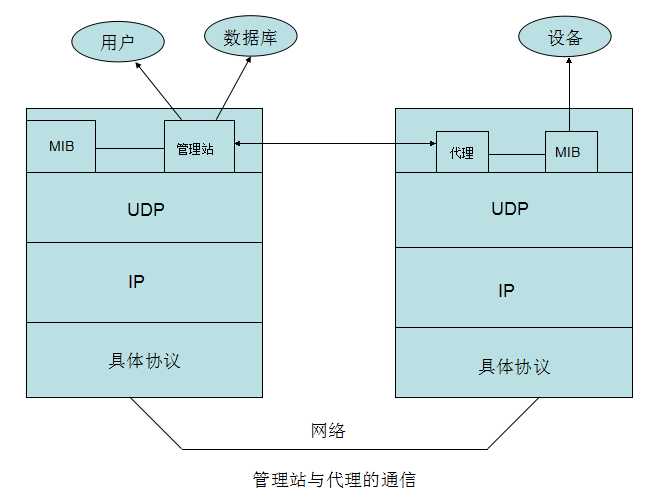
管理站与代理端通过MIB进行接口 统一,MIB定义了设备中的被管理对象。管理站和代理都实现了相应的MIB对象,使得双方可以识别对方的数据,实现通信。管理站向代理申请MIB中定义的 数据,代理识别后,将管理设备提供的相关状态或参数等数据转换为MIB定义的格式,应答给管理站,完成一次管理操作。
已 有的设备,只要新加一个SNMP模块就可以实现网络支持。旧的带扩展槽的设备,只要插入SNMP模块插卡即可支持网络管理。网络上的许多设备,路由器、交 换机等,都可以通过添加一个SNMP网管模块而增加网管功能。服务器可以通过运行一个网管进程实现。其他服务级的产品也可以通过网管模块实现网络管理,如 Oracle、WebLogic都有SNMP进程,运行后就可以通过管理站对这些系统级服务进行管理。
根据管理者和被管理的设备在网络管理操作中的不同职责,SNMP定义了3种角色。如下图,
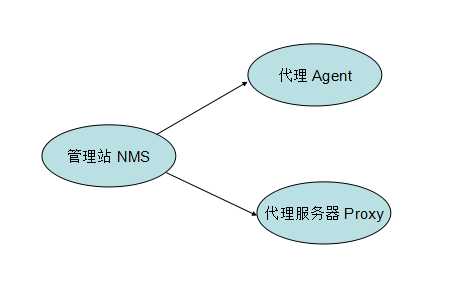
网络管理系统:又称管理站、NMS。是系统的控制台,向管理员提供界面以获取与改变设备的配置、信息、状态、操作等信息。管理站与Agent进行通信,执行相应的Set和Get操作,并接收代理发过来的警报(Trap)。
代 理:Agent是网络管理的代理人,负责管理站和设备SNMP操作的传递。介于管理站和设备之间,与管理站通信并相应管理站的请求,从设备获取相应的数 据,或对设备进行相应的设置,来响应管理站的请求。代理也需要具有根据设备的相应状态使用MIB中定义的Trap向管理站发送报告的能力。
代 理服务器:Proxy是一种特殊的代理,在不能直接使用SNMP协议的地方,如:异种网络、不同版本的SNMP代理等情况,Proxy代替相关设备向管理 站提供一种外观,为设备代理SNMP协议的实现。Proxy做了异种网络或不同版本代理和相应SNMP数据请求的转换工作。如下图,
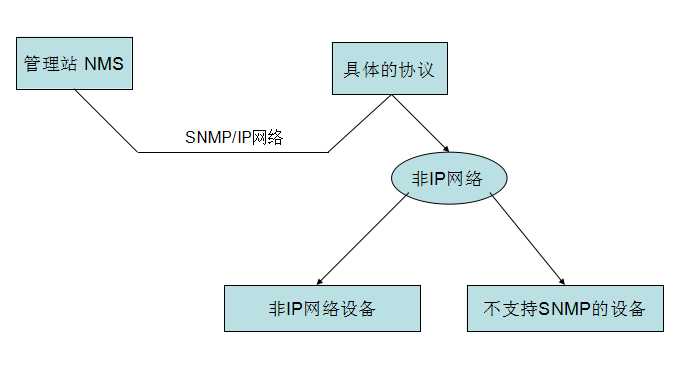
附:管理信息库MIB:定义了设备上可以使用的管理信息。代理和管理站使用MIB作为统一的数据接口通信。
六、SNMP的技术内容
如下图,
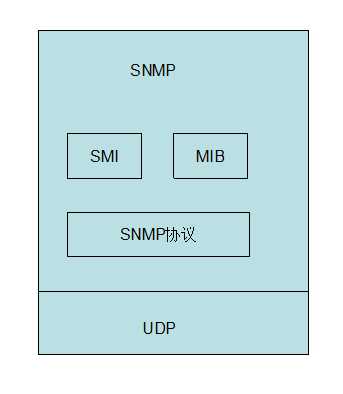
七、SNMP的发展历史
- 1989年—— SNMPv1
- 1991年—— RMON(Remote Network Monitoring 远程网络监视),它扩充了SNMP的功能,包括对LAN的管理及对依附于这些网络的设备的管理。RMON 没有修改和增加SNMPv1,只是增加了SNMP监视子网的能力。
- 1993年—— SNMPv2(SNMPv1的升级版)
- 1995年—— SNMPv2正式版,其中规定了如何在基于OSI的网络中使用SNMP
- 1995年—— RMON扩展为RMON2
- 1998年—— SNMPv3,一系列文档定义了SNMP的安全性,并定义了将来改进的总体结构,SNMPv3可以和SNMPv2、SNMPv1一起使用。
八、SNMP的技术术语
- SNMP:Simple Network Management Protocol(简单网络管理协议),是一个标准的用于管理基于IP网络上设备的协议。
- MIB:Management Information Base(管理信息库),定义代理进程中所有可被查询和修改的参数。
- SMI:Structure of Management Information(管理信息结构),SMI定义了SNMP中使用到的ASN.1类型、语法,并定义了SNMP中使用到的类型、宏、符号等。SMI用 于后续协议的描述和MIB的定义。每个版本的SNMP都可能定义自己的SMI。
- ASN.1:Abstract Syntax Notation One(抽象语法定义)。用于定义语法的正式语言,在SNMP中定义SNMP的协议数据单元PDU和管理对象MIB的格式。SNMP只使用了ASN.1中 的一部分,而且使用ASN.1的语言特性定义了一些自定义类型和类型宏 ,这些组成了SMI。
- PDU: Protocol Data Unit(协议数据单元),它是网络中传送的数据包。每一种SNMP操作,物理上都对应一个PDU。
- NMS: Network Management System,网络管理系统,又名网络管理站,简称“管理站”。它是SNMP的总控机,提供统一的用户界面访问支持SNMP的设备,一般提供UI界面,并 有统计、分析等功能,是网管系统的总控制台。NMS是网络管理操作的发起者。
- Agent: 是SNMP的访问代理,简称“代理”,为设备提供SNMP能力,负责设备与NMS的通信。
- Proxy: 代理服务器,对实现不同协议的设备进行协议转换,使非IP协议的设备也能被管理。
- Trap: 是由设备主动发出的报警数据,用于提示重要的状态的改变。
- BER: Basic Encoding Rule,基本编码规格。描述如何将ASN.1类型的值编码为字符串的方法。它是ASN.1标准的一部分。BER编码将数据分成TLV三部分,T为Tag 的缩写,是类型标识;L为Length的缩写,标识类型的长度;V为Value的缩写,标识数据内容。按照TLV的顺序对数据进行编码,生成字节流。 SNMP使用BER将SNMP的操作请求和应答编码后进行传输,并用于接收端进行解码。
九、综合上述(总结)
1.SNMP现有几个版本
SNMP共有v1,v2,v3这三个版本:
- v1和v2都具有基本的读、写MIB功能。
- v2增加了警报、批量数据获取、管理站和管理站通信能力。
- v3在v2的基础上增加了USM,使用加密的数据和用户验证技术,提高了安全性。
- 另外,RMON是SNMP的一个重要扩展,为SNMP增加了子网流量、统计、分析能力。现有两个版本: Rmon:提供了OSI七层网络结构中网络层和数据链路层监视能力。Rmon2:提供了OSI七层网络结构中网络层之上各层的监视能力。
2.ASN.1、BER、SMI、MIB、PDU的关系

- ASN.1:高级的数据描述语言。描述数据的类型、结构、组织、及编码方法。包括符号和语法两部分。SNMP使用ASN.1描述PDU和管理学对象信息库MIB。
- BER:ASN.1 的基本编码规则。描述具体的ASN.1对象如何编码为比特流在网络上传输。SNMP使用BER作为编码方案,数据首先先经过BER编码,再经由传输层协议 (一边是UDP)发往接收方。接收方在SNMP端口上收到PDU后,经过BER解码后,得到具体的SNMP操作数据。
- SMI:是SNMP的描述方法。规定了使用ASN.1子类型、符号。ASN.1功能强大,但SNMP只用到了其中很小一部分,对于这一部分内容的描述,限定了范围,即为SMI。SMI规定了使用到的ASN.1类型、宏、符号等。SMI是ASN.1的一个子集和超集。
- MIB: 是SNMP中使用到的管理信息库。定义了数据格式、类型、顺序、意义等,使用SMI中定义的类型和ASN.1中的基本类型对对象进行描述,是一个使用 SMI描述的管理信息库。每一类关心的事件都有一组MIB,比如网络接口有一颗MIB树,TCP有一颗MIB树,UDP也有一颗MIB树。
- PDU:是SNMP的协议数据单元。PDU是基本的通信格式,使用ASN.1描述,使用BER编码,通过传输层协议传送。
3.比较规范的SNMP背景
SNMP作为一种过渡技术以其简单易用的特性被广泛使用,使用的网络产品提供对SNMP的支持。SNMP还扩展了具有远程管理功能的RMON,使得管理人员可以对整个子网进行管理,而不是对整个子网内的设备进行管理。
十、Net-SNMP
1.net-snmp简介
使用net-snmp作为学习SNMP的工具,搭建一个net-snmp环境。Net-snmp是一个开源的SNMP项目。最新版本为:5.7.2。net-snmp支持snmpv1、snmpv2、snmpv3,支持基于IPv4和IPv6的SNMP应用程序。
- Net-snmp提供完整的API用于SNMP应用程序开发,包括C和Perl的API 。
- 一个功能强大且可扩展的SNMP代理:snmpd开发者可以开发动态模块扩展snmpd,net-snmp内置扩展子代理与主代理的通信协议。
- 提供众多命令行工具检查和使用SNMP协议
- 一个图形化的MIB浏览工具
- 一个Trap接收进程,用于接收和显示Trap,并将Trap记录到日志文件中。
2.net-snmp的安装与配置
官方网站: http://www.net-snmp.org/download.html ,net-snmp被很多商业化的Linux包含,但是大多数的Linux使用net-snmp的主代理实现Linux的SNMP支持。
./configure --with-default-snmp-version="3" --prefix="/usr/local/net-snmp" --with-sys-contact="@@no.where" --with-sys-location="China" --with-logfile="/var/log/snmpd.log" --with-persistent-directory="/var/net-snmp"
prefix:net-snmp将要安装的路径
enable-mfd-rewrites:允许用新的MFD重写可用的mid模块
with-default-snmp-version:默认的SNMP版本
with-sys-contact:可以配置该设备的联系人
with-sys-location:该设备的位置
with-logfile:日志文件路径
with-persistent-directory:不变数据存储目录
3.支持的平台
net-snmp可以在BSD UNIX、Linux、Windows等操作系统上编译运行。Windows下可以安装一个VMWare虚拟机软件,新建一个虚拟机,在虚拟机上安装Linux用来学习。
4.实验环境
- 操作系统,CentOS 6.4 X86_64
- 软件版本,net-snmp 5.5
5.同步时间
| 1 | [[email protected] ~]# ntpdate 202.120.2.101 |
6.安装yum源
|
1
2
|
[[email protected] ~]# rpm -ivh http://download.fedoraproject.org/pub/epel/6/x86_64/epel-release-6-8.noarch.rpm[[email protected] ~]# rpm -ivh http://pkgs.repoforge.org/rpmforge-release/rpmforge-release-0.5.3-1.el6.rf.x86_64.rpm |
7.查看一下net-snmp相关软件包
|
1
2
3
4
5
6
7
8
9
|
[[email protected] ~]# yum list all | grep net-snmp*net-snmp.x86_64 1:5.5-44.el6_4.4 updatesnet-snmp-devel.i686 1:5.5-44.el6_4.4 updatesnet-snmp-devel.x86_64 1:5.5-44.el6_4.4 updatesnet-snmp-libs.i686 1:5.5-44.el6_4.4 updatesnet-snmp-libs.x86_64 1:5.5-44.el6_4.4 updatesnet-snmp-perl.x86_64 1:5.5-44.el6_4.4 updatesnet-snmp-python.x86_64 1:5.5-44.el6_4.4 updatesnet-snmp-utils.x86_64 1:5.5-44.el6_4.4 updates |
注,有两个重要的安装,net-snmp.x86_64 、net-snmp-utils.x86_64 一个是net-snmp软件包,另一个是snmp的工具包。下面我们来安装一下,
| 1 | [[email protected] ~]# yum install -y net-snmp net-snmp-utils |
8.查看一下安装的软件包
|
1
2
3
4
|
[[email protected] ~]# rpm -qa | grep net-snmp*net-snmp-5.5-44.el6_4.4.x86_64net-snmp-utils-5.5-44.el6_4.4.x86_64net-snmp-libs-5.5-44.el6_4.4.x86_64 |
9.查看一下软件包具体安装的内容
下面是snmp软件包的内容,
|
1
2
3
4
5
6
7
8
9
10
11
12
13
14
15
16
17
18
19
20
21
22
23
24
25
26
27
28
29
30
31
32
33
34
35
36
37
38
39
40
41
42
43
44
45
46
47
48
49
50
51
52
53
54
55
56
57
58
59
60
61
62
63
64
65
|
[[email protected] ~]# rpm -ql net-snmp-5.5-44.el6_4.4.x86_64/etc/rc.d/init.d/snmpd #snmp的启动脚本/etc/rc.d/init.d/snmptrapd/etc/snmp #snmp配置文件目录/etc/snmp/snmpd.conf #snmp配置文件/etc/snmp/snmptrapd.conf/etc/sysconfig/snmpd/etc/sysconfig/snmptrapd/usr/bin/net-snmp-create-v3-user/usr/bin/snmpconf/usr/sbin/snmpd/usr/sbin/snmptrapd/usr/share/doc/net-snmp-5.5/usr/share/doc/net-snmp-5.5/AGENT.txt/usr/share/doc/net-snmp-5.5/COPYING/usr/share/doc/net-snmp-5.5/ChangeLog.trimmed/usr/share/doc/net-snmp-5.5/EXAMPLE.conf/usr/share/doc/net-snmp-5.5/FAQ/usr/share/doc/net-snmp-5.5/NEWS/usr/share/doc/net-snmp-5.5/PORTING/usr/share/doc/net-snmp-5.5/README/usr/share/doc/net-snmp-5.5/README.agent-mibs/usr/share/doc/net-snmp-5.5/README.agentx/usr/share/doc/net-snmp-5.5/README.krb5/usr/share/doc/net-snmp-5.5/README.mib2c/usr/share/doc/net-snmp-5.5/README.snmpv3/usr/share/doc/net-snmp-5.5/README.thread/usr/share/doc/net-snmp-5.5/TODO/usr/share/doc/net-snmp-5.5/ipf-mod.pl/usr/share/doc/net-snmp-5.5/passtest/usr/share/man/man1/net-snmp-create-v3-user.1.gz #帮助文件/usr/share/man/man1/snmpconf.1.gz/usr/share/man/man5/snmp_config.5.gz/usr/share/man/man5/snmpd.conf.5.gz/usr/share/man/man5/snmpd.examples.5.gz/usr/share/man/man5/snmpd.internal.5.gz/usr/share/man/man5/snmptrapd.conf.5.gz/usr/share/man/man5/variables.5.gz/usr/share/man/man8/snmpd.8.gz/usr/share/man/man8/snmptrapd.8.gz/usr/share/snmp/usr/share/snmp/snmpconf-data/usr/share/snmp/snmpconf-data/snmp-data/usr/share/snmp/snmpconf-data/snmp-data/authopts/usr/share/snmp/snmpconf-data/snmp-data/debugging/usr/share/snmp/snmpconf-data/snmp-data/mibs/usr/share/snmp/snmpconf-data/snmp-data/output/usr/share/snmp/snmpconf-data/snmp-data/snmpconf-config/usr/share/snmp/snmpconf-data/snmpd-data/usr/share/snmp/snmpconf-data/snmpd-data/acl/usr/share/snmp/snmpconf-data/snmpd-data/basic_setup/usr/share/snmp/snmpconf-data/snmpd-data/extending/usr/share/snmp/snmpconf-data/snmpd-data/monitor/usr/share/snmp/snmpconf-data/snmpd-data/operation/usr/share/snmp/snmpconf-data/snmpd-data/snmpconf-config/usr/share/snmp/snmpconf-data/snmpd-data/system/usr/share/snmp/snmpconf-data/snmpd-data/trapsinks/usr/share/snmp/snmpconf-data/snmptrapd-data/usr/share/snmp/snmpconf-data/snmptrapd-data/authentication/usr/share/snmp/snmpconf-data/snmptrapd-data/formatting/usr/share/snmp/snmpconf-data/snmptrapd-data/logging/usr/share/snmp/snmpconf-data/snmptrapd-data/runtime/usr/share/snmp/snmpconf-data/snmptrapd-data/snmpconf-config/usr/share/snmp/snmpconf-data/snmptrapd-data/traphandle/var/run/net-snmp |
下面是snmp的常用操作工具,
|
1
2
3
4
5
6
7
8
9
10
11
12
13
14
15
16
17
18
19
20
21
22
23
24
25
26
27
28
29
30
31
32
33
34
35
36
37
38
39
40
41
|
[[email protected] ~]# rpm -ql net-snmp-utils-5.5-44.el6_4.4.x86_64/usr/bin/encode_keychange/usr/bin/snmpbulkget #下面是snmp常用工具,下面我们会详细讲解/usr/bin/snmpbulkwalk/usr/bin/snmpdelta/usr/bin/snmpdf/usr/bin/snmpget/usr/bin/snmpgetnext/usr/bin/snmpinform/usr/bin/snmpnetstat/usr/bin/snmpset/usr/bin/snmpstatus/usr/bin/snmptable/usr/bin/snmptest/usr/bin/snmptranslate/usr/bin/snmptrap/usr/bin/snmpusm/usr/bin/snmpvacm/usr/bin/snmpwalk/usr/share/man/man1/encode_keychange.1.gz/usr/share/man/man1/snmpbulkget.1.gz/usr/share/man/man1/snmpbulkwalk.1.gz/usr/share/man/man1/snmpcmd.1.gz/usr/share/man/man1/snmpconf.1.gz/usr/share/man/man1/snmpdelta.1.gz/usr/share/man/man1/snmpdf.1.gz/usr/share/man/man1/snmpget.1.gz/usr/share/man/man1/snmpgetnext.1.gz/usr/share/man/man1/snmpinform.1.gz/usr/share/man/man1/snmpnetstat.1.gz/usr/share/man/man1/snmpset.1.gz/usr/share/man/man1/snmpstatus.1.gz/usr/share/man/man1/snmptable.1.gz/usr/share/man/man1/snmptest.1.gz/usr/share/man/man1/snmptranslate.1.gz/usr/share/man/man1/snmptrap.1.gz/usr/share/man/man1/snmpusm.1.gz/usr/share/man/man1/snmpvacm.1.gz/usr/share/man/man1/snmpwalk.1.gz/usr/share/man/man5/snmp.conf.5.gz/usr/share/man/man5/variables.5.gz |
10.查看一下默认配置文件
注,大家可以看到默认配置文件有很多内容,但其实大部分都是注释。下面我们来讲解一下常用的配置选项,
|
1
2
3
4
5
6
7
8
9
10
11
12
13
14
15
16
17
18
19
20
21
22
23
24
25
26
27
28
29
30
31
32
33
34
35
36
37
38
39
40
41
42
43
44
45
46
47
48
49
50
51
52
53
54
55
56
57
58
59
60
61
62
63
64
65
66
67
68
69
70
71
72
73
74
75
76
77
78
79
80
81
82
83
84
85
86
87
88
89
90
91
92
93
94
95
96
97
98
99
100
101
102
103
104
105
106
107
108
109
110
111
112
113
114
115
116
117
118
119
120
121
122
123
124
125
126
127
128
129
130
131
132
133
134
135
136
137
138
139
140
141
142
143
144
145
146
147
148
149
150
151
152
153
154
155
156
157
158
159
160
161
162
163
164
165
166
167
168
169
170
171
172
173
174
175
176
177
178
179
180
181
182
183
184
185
186
187
188
189
190
191
192
193
194
195
196
197
198
199
200
201
202
203
204
205
206
207
208
209
210
211
212
213
214
215
216
217
218
219
220
221
222
223
224
225
226
227
228
229
230
231
232
233
234
235
236
237
238
239
240
241
242
243
244
245
246
247
248
249
250
251
252
253
254
255
256
257
258
259
260
261
262
263
264
265
266
267
268
269
270
271
272
273
274
275
276
277
278
279
280
281
282
283
284
285
286
287
288
289
290
291
292
293
294
295
296
297
298
299
300
301
302
303
304
305
306
307
308
309
310
311
312
313
314
315
316
317
318
319
320
321
322
323
324
325
326
327
328
329
330
331
332
333
334
335
336
337
338
339
340
341
342
343
344
345
346
347
348
349
350
351
352
353
354
355
356
357
358
359
360
361
362
363
364
365
366
367
368
369
370
371
372
373
374
375
376
377
378
379
380
|
[[email protected] ~]# cat /etc/snmp/snmpd.conf################################################################################# snmpd.conf:# An example configuration file for configuring the ucd-snmp snmpd agent.################################################################################## This file is intended to only be as a starting point. Many more# configuration directives exist than are mentioned in this file. For# full details, see the snmpd.conf(5) manual page.## All lines beginning with a ‘#‘ are comments and are intended for you# to read. All other lines are configuration commands for the agent.################################################################################ Access Control################################################################################ As shipped, the snmpd demon will only respond to queries on the# system mib group until this file is replaced or modified for# security purposes. Examples are shown below about how to increase the# level of access.# By far, the most common question I get about the agent is "why won‘t# it work?", when really it should be "how do I configure the agent to# allow me to access it?"## By default, the agent responds to the "public" community for read# only access, if run out of the box without any configuration file in# place. The following examples show you other ways of configuring# the agent so that you can change the community names, and give# yourself write access to the mib tree as well.## For more information, read the FAQ as well as the snmpd.conf(5)# manual page.##### First, map the community name "public" into a "security name"# sec.name source communitycom2sec notConfigUser default public##### Second, map the security name into a group name:# groupName securityModel securityNamegroup notConfigGroup v1 notConfigUsergroup notConfigGroup v2c notConfigUser##### Third, create a view for us to let the group have rights to:# Make at least snmpwalk -v 1 localhost -c public system fast again.# name incl/excl subtree mask(optional)view systemview included .1.3.6.1.2.1.1view systemview included .1.3.6.1.2.1.25.1.1##### Finally, grant the group read-only access to the systemview view.# group context sec.model sec.level prefix read write notifaccess notConfigGroup "" any noauth exact systemview none none# -----------------------------------------------------------------------------#下面的是一个例子,具体是关于怎么对本机或其他网络主机赋予权限# Here is a commented out example configuration that allows less# restrictive access.# YOU SHOULD CHANGE THE "COMMUNITY" TOKEN BELOW TO A NEW KEYWORD ONLY# KNOWN AT YOUR SITE. YOU *MUST* CHANGE THE NETWORK TOKEN BELOW TO# SOMETHING REFLECTING YOUR LOCAL NETWORK ADDRESS SPACE.## sec.name source community#com2sec local localhost COMMUNITY#com2sec mynetwork NETWORK/24 COMMUNITY## group.name sec.model sec.name#group MyRWGroup any local#group MyROGroup any mynetwork##group MyRWGroup any otherv3user#...## incl/excl subtree mask#view all included .1 80## -or just the mib2 tree-#view mib2 included .iso.org.dod.internet.mgmt.mib-2 fc## context sec.model sec.level prefix read write notif#access MyROGroup "" any noauth 0 all none none#access MyRWGroup "" any noauth 0 all all all################################################################################ Sample configuration to make net-snmpd RFC 1213.# Unfortunately v1 and v2c don‘t allow any user based authentification, so# opening up the default config is not an option from a security point.## WARNING: If you uncomment the following lines you allow write access to your# snmpd daemon from any source! To avoid this use different names for your# community or split out the write access to a different community and# restrict it to your local network.# Also remember to comment the syslocation and syscontact parameters later as# otherwise they are still read only (see FAQ for net-snmp).## First, map the community name "public" into a "security name"# sec.name source community#com2sec notConfigUser default public# Second, map the security name into a group name:# groupName securityModel securityName#group notConfigGroup v1 notConfigUser#group notConfigGroup v2c notConfigUser# Third, create a view for us to let the group have rights to:# Open up the whole tree for ro, make the RFC 1213 required ones rw.# name incl/excl subtree mask(optional)#view roview included .1#view rwview included system.sysContact#view rwview included system.sysName#view rwview included system.sysLocation#view rwview included interfaces.ifTable.ifEntry.ifAdminStatus#view rwview included at.atTable.atEntry.atPhysAddress#view rwview included at.atTable.atEntry.atNetAddress#view rwview included ip.ipForwarding#view rwview included ip.ipDefaultTTL#view rwview included ip.ipRouteTable.ipRouteEntry.ipRouteDest#view rwview included ip.ipRouteTable.ipRouteEntry.ipRouteIfIndex#view rwview included ip.ipRouteTable.ipRouteEntry.ipRouteMetric1#view rwview included ip.ipRouteTable.ipRouteEntry.ipRouteMetric2#view rwview included ip.ipRouteTable.ipRouteEntry.ipRouteMetric3#view rwview included ip.ipRouteTable.ipRouteEntry.ipRouteMetric4#view rwview included ip.ipRouteTable.ipRouteEntry.ipRouteType#view rwview included ip.ipRouteTable.ipRouteEntry.ipRouteAge#view rwview included ip.ipRouteTable.ipRouteEntry.ipRouteMask#view rwview included ip.ipRouteTable.ipRouteEntry.ipRouteMetric5#view rwview included ip.ipNetToMediaTable.ipNetToMediaEntry.ipNetToMediaIfIndex#view rwview included ip.ipNetToMediaTable.ipNetToMediaEntry.ipNetToMediaPhysAddress#view rwview included ip.ipNetToMediaTable.ipNetToMediaEntry.ipNetToMediaNetAddress#view rwview included ip.ipNetToMediaTable.ipNetToMediaEntry.ipNetToMediaType#view rwview included tcp.tcpConnTable.tcpConnEntry.tcpConnState#view rwview included egp.egpNeighTable.egpNeighEntry.egpNeighEventTrigger#view rwview included snmp.snmpEnableAuthenTraps# Finally, grant the group read-only access to the systemview view.# group context sec.model sec.level prefix read write notif#access notConfigGroup "" any noauth exact roview rwview none################################################################################ System contact information#联系人信息# It is also possible to set the sysContact and sysLocation system# variables through the snmpd.conf file:syslocation Unknown (edit /etc/snmp/snmpd.conf)# Example output of snmpwalk:# % snmpwalk -v 1 localhost -c public system# system.sysDescr.0 = "SunOS name sun4c"# system.sysObjectID.0 = OID: enterprises.ucdavis.ucdSnmpAgent.sunos4# system.sysUpTime.0 = Timeticks: (595637548) 68 days, 22:32:55# system.sysContact.0 = "Me <[email protected]>"# system.sysName.0 = "name"# system.sysLocation.0 = "Right here, right now."# system.sysServices.0 = 72################################################################################ Logging#日志信息# We do not want annoying "Connection from UDP: " messages in syslog.# If the following option is commented out, snmpd will print each incoming# connection, which can be useful for debugging.dontLogTCPWrappersConnects yes# -----------------------------------------------------------------------------################################################################################ Process checks.#关于检测进程数目的有个OIDs,可以在enterprises.ucdavis.procTable查看# The following are examples of how to use the agent to check for# processes running on the host. The syntax looks something like:## proc NAME [MAX=0] [MIN=0]## NAME: the name of the process to check for. It must match# exactly (ie, http will not find httpd processes).# MAX: the maximum number allowed to be running. Defaults to 0.# MIN: the minimum number to be running. Defaults to 0.## Examples (commented out by default):## Make sure mountd is running#proc mountd# Make sure there are no more than 4 ntalkds running, but 0 is ok too.#proc ntalkd 4# Make sure at least one sendmail, but less than or equal to 10 are running.#proc sendmail 10 1# A snmpwalk of the process mib tree would look something like this:## % snmpwalk -v 1 localhost -c public .1.3.6.1.4.1.2021.2# enterprises.ucdavis.procTable.prEntry.prIndex.1 = 1# enterprises.ucdavis.procTable.prEntry.prIndex.2 = 2# enterprises.ucdavis.procTable.prEntry.prIndex.3 = 3# enterprises.ucdavis.procTable.prEntry.prNames.1 = "mountd"# enterprises.ucdavis.procTable.prEntry.prNames.2 = "ntalkd"# enterprises.ucdavis.procTable.prEntry.prNames.3 = "sendmail"# enterprises.ucdavis.procTable.prEntry.prMin.1 = 0# enterprises.ucdavis.procTable.prEntry.prMin.2 = 0# enterprises.ucdavis.procTable.prEntry.prMin.3 = 1# enterprises.ucdavis.procTable.prEntry.prMax.1 = 0# enterprises.ucdavis.procTable.prEntry.prMax.2 = 4# enterprises.ucdavis.procTable.prEntry.prMax.3 = 10# enterprises.ucdavis.procTable.prEntry.prCount.1 = 0# enterprises.ucdavis.procTable.prEntry.prCount.2 = 0# enterprises.ucdavis.procTable.prEntry.prCount.3 = 1# enterprises.ucdavis.procTable.prEntry.prErrorFlag.1 = 1# enterprises.ucdavis.procTable.prEntry.prErrorFlag.2 = 0# enterprises.ucdavis.procTable.prEntry.prErrorFlag.3 = 0# enterprises.ucdavis.procTable.prEntry.prErrMessage.1 = "No mountd process running."# enterprises.ucdavis.procTable.prEntry.prErrMessage.2 = ""# enterprises.ucdavis.procTable.prEntry.prErrMessage.3 = ""# enterprises.ucdavis.procTable.prEntry.prErrFix.1 = 0# enterprises.ucdavis.procTable.prEntry.prErrFix.2 = 0# enterprises.ucdavis.procTable.prEntry.prErrFix.3 = 0## Note that the errorFlag for mountd is set to 1 because one is not# running (in this case an rpc.mountd is, but thats not good enough),# and the ErrMessage tells you what‘s wrong. The configuration# imposed in the snmpd.conf file is also shown.## Special Case: When the min and max numbers are both 0, it assumes# you want a max of infinity and a min of 1.## -----------------------------------------------------------------------------################################################################################ Executables/scripts#snmpd可以运行一个脚本,并可以得到他的返回值(最后一个)在enterprises.ucdavis.extTable下查看## You can also have programs run by the agent that return a single# line of output and an exit code. Here are two examples.## exec NAME PROGRAM [ARGS ...]## NAME: A generic name. The name must be unique for each exec statement.# PROGRAM: The program to run. Include the path!# ARGS: optional arguments to be passed to the program# a simple hello world#exec echotest /bin/echo hello world# Run a shell script containing:## #!/bin/sh# echo hello world# echo hi there# exit 35## Note: this has been specifically commented out to prevent# accidental security holes due to someone else on your system writing# a /tmp/shtest before you do. Uncomment to use it.##exec shelltest /bin/sh /tmp/shtest# Then,# % snmpwalk -v 1 localhost -c public .1.3.6.1.4.1.2021.8# enterprises.ucdavis.extTable.extEntry.extIndex.1 = 1# enterprises.ucdavis.extTable.extEntry.extIndex.2 = 2# enterprises.ucdavis.extTable.extEntry.extNames.1 = "echotest"# enterprises.ucdavis.extTable.extEntry.extNames.2 = "shelltest"# enterprises.ucdavis.extTable.extEntry.extCommand.1 = "/bin/echo hello world"# enterprises.ucdavis.extTable.extEntry.extCommand.2 = "/bin/sh /tmp/shtest"# enterprises.ucdavis.extTable.extEntry.extResult.1 = 0# enterprises.ucdavis.extTable.extEntry.extResult.2 = 35# enterprises.ucdavis.extTable.extEntry.extOutput.1 = "hello world."# enterprises.ucdavis.extTable.extEntry.extOutput.2 = "hello world."# enterprises.ucdavis.extTable.extEntry.extErrFix.1 = 0# enterprises.ucdavis.extTable.extEntry.extErrFix.2 = 0# Note that the second line of the /tmp/shtest shell script is cut# off. Also note that the exit status of 35 was returned.# -----------------------------------------------------------------------------################################################################################ disk checks#硬盘分区的定义,语法如下,只有定义了才会取抓值。单位KB# The agent can check the amount of available disk space, and make# sure it is above a set limit.# disk PATH [MIN=100000]## PATH: mount path to the disk in question.# MIN: Disks with space below this value will have the Mib‘s errorFlag set.# Default value = 100000.# Check the / partition and make sure it contains at least 10 megs.#disk / 10000# % snmpwalk -v 1 localhost -c public .1.3.6.1.4.1.2021.9# enterprises.ucdavis.diskTable.dskEntry.diskIndex.1 = 0# enterprises.ucdavis.diskTable.dskEntry.diskPath.1 = "/" Hex: 2F# enterprises.ucdavis.diskTable.dskEntry.diskDevice.1 = "/dev/dsk/c201d6s0"# enterprises.ucdavis.diskTable.dskEntry.diskMinimum.1 = 10000# enterprises.ucdavis.diskTable.dskEntry.diskTotal.1 = 837130# enterprises.ucdavis.diskTable.dskEntry.diskAvail.1 = 316325# enterprises.ucdavis.diskTable.dskEntry.diskUsed.1 = 437092# enterprises.ucdavis.diskTable.dskEntry.diskPercent.1 = 58# enterprises.ucdavis.diskTable.dskEntry.diskErrorFlag.1 = 0# enterprises.ucdavis.diskTable.dskEntry.diskErrorMsg.1 = ""# -----------------------------------------------------------------------------################################################################################ load average checks#这个是定义cpu任务的负载信息的,值是平均最大值# load [1MAX=12.0] [5MAX=12.0] [15MAX=12.0]## 1MAX: If the 1 minute load average is above this limit at query# time, the errorFlag will be set.# 5MAX: Similar, but for 5 min average.# 15MAX: Similar, but for 15 min average.# Check for loads:#load 12 14 14# % snmpwalk -v 1 localhost -c public .1.3.6.1.4.1.2021.10# enterprises.ucdavis.loadTable.laEntry.loadaveIndex.1 = 1# enterprises.ucdavis.loadTable.laEntry.loadaveIndex.2 = 2# enterprises.ucdavis.loadTable.laEntry.loadaveIndex.3 = 3# enterprises.ucdavis.loadTable.laEntry.loadaveNames.1 = "Load-1"# enterprises.ucdavis.loadTable.laEntry.loadaveNames.2 = "Load-5"# enterprises.ucdavis.loadTable.laEntry.loadaveNames.3 = "Load-15"# enterprises.ucdavis.loadTable.laEntry.loadaveLoad.1 = "0.49" Hex: 30 2E 34 39# enterprises.ucdavis.loadTable.laEntry.loadaveLoad.2 = "0.31" Hex: 30 2E 33 31# enterprises.ucdavis.loadTable.laEntry.loadaveLoad.3 = "0.26" Hex: 30 2E 32 36# enterprises.ucdavis.loadTable.laEntry.loadaveConfig.1 = "12.00"# enterprises.ucdavis.loadTable.laEntry.loadaveConfig.2 = "14.00"# enterprises.ucdavis.loadTable.laEntry.loadaveConfig.3 = "14.00"# enterprises.ucdavis.loadTable.laEntry.loadaveErrorFlag.1 = 0# enterprises.ucdavis.loadTable.laEntry.loadaveErrorFlag.2 = 0# enterprises.ucdavis.loadTable.laEntry.loadaveErrorFlag.3 = 0# enterprises.ucdavis.loadTable.laEntry.loadaveErrMessage.1 = ""# enterprises.ucdavis.loadTable.laEntry.loadaveErrMessage.2 = ""# enterprises.ucdavis.loadTable.laEntry.loadaveErrMessage.3 = ""# -----------------------------------------------------------------------------################################################################################ Extensible sections.# 与enterprises.ucdavis.extTable的区别# This alleviates the multiple line output problem found in the# previous executable mib by placing each mib in its own mib table:# Run a shell script containing:## #!/bin/sh# echo hello world# echo hi there# exit 35## Note: this has been specifically commented out to prevent# accidental security holes due to someone else on your system writing# a /tmp/shtest before you do. Uncomment to use it.## exec .1.3.6.1.4.1.2021.50 shelltest /bin/sh /tmp/shtest# % snmpwalk -v 1 localhost -c public .1.3.6.1.4.1.2021.50# enterprises.ucdavis.50.1.1 = 1# enterprises.ucdavis.50.2.1 = "shelltest"# enterprises.ucdavis.50.3.1 = "/bin/sh /tmp/shtest"# enterprises.ucdavis.50.100.1 = 35# enterprises.ucdavis.50.101.1 = "hello world."# enterprises.ucdavis.50.101.2 = "hi there."# enterprises.ucdavis.50.102.1 = 0# Now the Output has grown to two lines, and we can see the ‘hi# there.‘ output as the second line from our shell script.## Note that you must alter the mib.txt file to be correct if you want# the .50.* outputs above to change to reasonable text descriptions.# Other ideas:## exec .1.3.6.1.4.1.2021.51 ps /bin/ps# exec .1.3.6.1.4.1.2021.52 top /usr/local/bin/top# exec .1.3.6.1.4.1.2021.53 mailq /usr/bin/mailq#可以运行多个脚本# -----------------------------------------------------------------------------################################################################################ Pass through control.## Usage:# pass MIBOID EXEC-COMMAND## This will pass total control of the mib underneath the MIBOID# portion of the mib to the EXEC-COMMAND.## Note: You‘ll have to change the path of the passtest script to your# source directory or install it in the given location.## Example: (see the script for details)# (commented out here since it requires that you place the# script in the right location. (its not installed by default))# pass .1.3.6.1.4.1.2021.255 /bin/sh /usr/local/local/passtest# % snmpwalk -v 1 localhost -c public .1.3.6.1.4.1.2021.255# enterprises.ucdavis.255.1 = "life the universe and everything"# enterprises.ucdavis.255.2.1 = 42# enterprises.ucdavis.255.2.2 = OID: 42.42.42# enterprises.ucdavis.255.3 = Timeticks: (363136200) 42 days, 0:42:42# enterprises.ucdavis.255.4 = IpAddress: 127.0.0.1# enterprises.ucdavis.255.5 = 42# enterprises.ucdavis.255.6 = Gauge: 42## % snmpget -v 1 localhost public .1.3.6.1.4.1.2021.255.5# enterprises.ucdavis.255.5 = 42## % snmpset -v 1 localhost public .1.3.6.1.4.1.2021.255.1 s "New string"# enterprises.ucdavis.255.1 = "New string"## For specific usage information, see the man/snmpd.conf.5 manual page# as well as the local/passtest script used in the above example.################################################################################ Further Information## See the snmpd.conf manual page, and the output of "snmpd -H". |
下面是常用的配置选项,
主配置文件:/etc/snmp/snmpd.conf
常用定义项:
(1). 首选是定义一个共同体名(community),这里是public(多数SNMP设备或服务默认都是是用public),及可以访问这个public的 用户名(sec name),这里是notConfigUser。Public相当于用户notConfigUser的密码:) ,source 在net-snmp中用来对来源IP加以控制,即哪些可以获取SNMP信息
|
1
2
|
# sec.name source communitycom2sec notConfigUser default public |
(2).定义一个组名(groupName)这里是notConfigGroup,及组的安全级别,把notConfigGroup这个用户加到这个组中。
sec.model:安全模式,可选值为v1/v2c/usm。
|
1
2
3
|
# groupName securityModel securityNamegroup notConfigGroup v1 notConfigUsergroup notConfigGroup v2c notConfigUser |
(3).定义一个可操作的范围(view)名, 这里是all,范围是 .1
|
1
2
|
# name incl/excl subtree mask(optional)view all included .1 #表示可以查看.1节点下的所有设备信息 |
注:
- incl/excl:对下面的MIB子树是包括还是排除。
- subtree:视图中涉及的MIB子树。
- mask:掩码
(4).定义notConfigUser这个组在all这个view范围内可做的操作(即权限),这时定义了notConfigUser组的成员可对.1这个范围做只读操作。
|
1
2
|
# group context sec.model sec.level prefix read write notifaccess notConfigGroup "" any noauth exact all none none |
注:
- context:上下文,v1、v2c中始终为空。
- sec.model:安全模式,可选值为v1/v2c/usm。
- sec.level:安全级别,可选值为auth/noauth/priv,v1、v2c中只能为noauth。
- prefix:前缀,指定context如何与PDU中的context匹配,v3使用。
- read:授权的读视图。
- write:授权的写视图。
- notif:授权的trap视图。
(5).端口: 标准的SNMP服务使用161和162端口,厂商私有的实现一般使用199、391、705和1993端口,net-snmp用udp 161。
11.启动snmp
|
1
2
3
4
5
6
7
8
9
10
11
12
13
14
15
|
[[email protected] ~]# service snmpd start正在启动 snmpd: [确定][[email protected] ~]# netstat -ntulpActive Internet connections (only servers)Proto Recv-Q Send-Q Local Address Foreign Address State PID/Program nametcp 0 0 0.0.0.0:22 0.0.0.0:* LISTEN 1045/sshdtcp 0 0 127.0.0.1:25 0.0.0.0:* LISTEN 1122/mastertcp 0 0 127.0.0.1:6010 0.0.0.0:* LISTEN 2149/sshdtcp 0 0 127.0.0.1:6011 0.0.0.0:* LISTEN 1582/sshdtcp 0 0 127.0.0.1:199 0.0.0.0:* LISTEN 12252/snmpdtcp 0 0 :::22 :::* LISTEN 1045/sshdtcp 0 0 ::1:25 :::* LISTEN 1122/mastertcp 0 0 ::1:6010 :::* LISTEN 2149/sshdtcp 0 0 ::1:6011 :::* LISTEN 1582/sshdudp 0 0 0.0.0.0:161 0.0.0.0:* 12252/snmpd |
12.测试一下
|
1
2
3
4
|
[[email protected] ~]# snmpd -v #查看一下net-snmp版本NET-SNMP version: 5.5Web: http://www.net-snmp.org/Email: net-snmp-[email protected].sourceforge.net |
注,启动代理时也可以使用如下参数使snmpd使用【配置文件】启动:
|
1
2
3
|
[[email protected] ~]# snmpd –C –c /etc/snmp/snmpd.conf-C 不读取默认配置文件-c 读取指定的配置文件 |
使用这个参数,我们可以配置很多的配置文件,设置不同的运行环境,便于我们开发和学习。
下面来测试一下,
从代理中读取一个管理对象验证代理是否正常运行。读取MIB库中的RFC1213->system->sysDescr 对象,该对象表示设备的描述信息。使用net-snmp提供的snmp工具读取,命令如下:
|
1
2
|
[[email protected] ~]# snmpget -v 2c -c public localhost sysDescr.0SNMPv2-MIB::sysDescr.0 = STRING: Linux node1.test.com 2.6.32-358.el6.x86_64 #1 SMP Fri Feb 22 00:31:26 UTC 2013 x86_64 |
注,如果得到了信息,表示net-snmp安装成功。
13.net-snmp工具介绍
|
1
2
3
4
|
[[email protected] ~]# snmpsnmpbulkget snmpd snmpget snmpnetstat snmptable snmptrap snmpvacmsnmpbulkwalk snmpdelta snmpgetnext snmpset snmptest snmptrapd snmpwalksnmpconf snmpdf snmpinform snmpstatus snmptranslate snmpusm |
- snmpget 模拟snmp的GetRequest操作的工具。用来获取一个或几个管理信息。用来读取管理信息的内容。
- snmpgetnext 模拟snmp的GetNextRequest操作的工具。用来获取一个管理信息实例的下一个可用实例数据。一般用来遍历SNMP中的表格数据。
- snmpset 模拟snmp的SetRequest操作的工具。用来设置可以写的管理信息。一般用来配置设备或对设备执行操作。
- snmpbulkget 模拟snmp的GetBulkRequest操作的工具。用来获取大块的数据。一般在大量读取大块数据时使用,以提高带宽利用率,并且比使用 snmpget、snmpgetnext及snmpwalk有更强的容错能力,代理会返回尽可能多的数据,比其它命令更有保证。
- snmpwalk 利用GetNextRequest对给定的管理树进行遍历的工具。一般用来对表格类型管理信息进行遍历。
- snmptrap 模拟trap的工具。用来发送模拟trap。一般用来测试管理站安装和配置是否正确,或者用来验证开发的Trap接收程序是否可以正常工作。
- snmptrapd 接收并显示trap的工具。一般在代理的开发过程中,接收代理发来的Trap,并将PDU细节打印出来,也来测试Trap发送功能是否正常。
- snmpinform 模拟发送InformRequest的工具。跟snmptrap类似,用来发送模拟的带应答的Trap,以测试管理站或自己开发的接收程序。
- snmptable 使用GetNextRequest 和 GetBulkRequest操作读取表信息,以列表形式显示的工具。
- snmpstatus 从SNMP实体读取几个重要的管理信息以确定设备状态的工具。用来简单测定设备状态。
- snmpbulkwalk 利用GetBulkRequest实现对给定管理树进行遍历的工具。对表格类型的管理信息进行遍历读取。
- snmpdelta 用来监视Integer类型的管理对象,会及时报告值改变情况的工具。用于监测一个设备或开发中的代理。
- snmptest 是一个复杂的工具,可以监测和管理一个网络实体的信息,通过SNMP请求操作与管理实体通信。
- snmptranslate 将对象名字和标识符相互转换的工具。用于数据格式的对象标识和可读式字符串的数据名称的转换。类似于域名与IP地址的关系。
- snmpusm SNMPv3 USM配置工具。用于SNMPv3的用户管理。
- snmpvacm 为一个网络实体创建和维护SNMPv3的基于视图访问控制参数的工具。用于维护SNMPv3的视图访问控制。
- snmpconf 生成snmpd配置文件的工具。用于生成snmpd的各种配置文件,用作模板,以生成用户级配置文件。
- snmpd Net-snmp开发的主代理程序,包括众多标准MIB的实现。还可以使用子代理对其进行扩展,是一个功能强大的SNMP代理。Linux、Unix和 Windows系统运行snmpd后,直接具备了SNMP协议支持,可以被管理站管理。许多商业化的Linux中使用snmpd作为系统的SNMP代理。
- snmpdf 通过SNMP访问并显示网络实体磁盘利用情况的工具。用来监测网络实体的磁盘。
下面我们来说几个最常用的net-snmp工具,
常用命令:
(1).snmpget命令
|
1
2
3
4
5
|
snmpget [OPTIONS] AGENT OID [OID]...选项:-v 1|2c|3 指定SNMP版本-c COMMUNITY 指定community string-m MIB[:...] 指定MIB文件 |
注,snmpget 不同于 snmpwalk ,必须在命令行给出 <object>.<instance> 的格式,不能只给出 object。
案例,snmpget -v 2c -c public localhost system.sysDescr.0 #获取设备的描述信息。
|
1
2
|
[[email protected] ~]# snmpget -v 2c -c public localhost system.sysDescr.0SNMPv2-MIB::sysDescr.0 = STRING: Linux node1.test.com 2.6.32-358.el6.x86_64 #1 SMP Fri Feb 22 00:31:26 UTC 2013 x86_64 |
(2).snmpwalk/snmpbulkwalk 命令
|
1
2
3
4
5
|
snmpwalk/snmpbulkwalk [OPTIONS] AGENT [OID]选项:-v 1|2c|3 指定SNMP版本-c COMMUNITY 指定community string-m MIB[:...] 指定MIB文件 |
注,snmpbulkwalk命令: 获取snmp服务器的mib-2各种资讯,snmpbulkwalk用于通过SNMPv2 的SNMP GET BULK请求命令与其它网络实体通信,只能用于snmpv2,速度快于snmpwalk
案例,snmpbulkwalk -v 2c -c public 127.0.0.1 .1.3.6.1.2.1.1 #获取mib-2的system的数据。
|
1
2
3
4
5
6
7
8
9
10
11
12
13
14
15
16
17
18
19
20
21
22
23
24
25
26
27
28
29
30
31
32
|
[[email protected] ~]# snmpbulkwalk -v 2c -c public 127.0.0.1 .1.3.6.1.2.1.1SNMPv2-MIB::sysDescr.0 = STRING: Linux node1.test.com 2.6.32-358.el6.x86_64 #1 SMP Fri Feb 22 00:31:26 UTC 2013 x86_64SNMPv2-MIB::sysObjectID.0 = OID: NET-SNMP-MIB::netSnmpAgentOIDs.10DISMAN-EVENT-MIB::sysUpTimeInstance = Timeticks: (264551) 0:44:05.51SNMPv2-MIB::sysName.0 = STRING: node1.test.comSNMPv2-MIB::sysLocation.0 = STRING: Unknown (edit /etc/snmp/snmpd.conf)SNMPv2-MIB::sysORLastChange.0 = Timeticks: (10) 0:00:00.10SNMPv2-MIB::sysORID.1 = OID: SNMP-MPD-MIB::snmpMPDMIBObjects.3.1.1SNMPv2-MIB::sysORID.2 = OID: SNMP-USER-BASED-SM-MIB::usmMIBComplianceSNMPv2-MIB::sysORID.3 = OID: SNMP-FRAMEWORK-MIB::snmpFrameworkMIBComplianceSNMPv2-MIB::sysORID.4 = OID: SNMPv2-MIB::snmpMIBSNMPv2-MIB::sysORID.5 = OID: TCP-MIB::tcpMIBSNMPv2-MIB::sysORID.6 = OID: IP-MIB::ipSNMPv2-MIB::sysORID.7 = OID: UDP-MIB::udpMIBSNMPv2-MIB::sysORID.8 = OID: SNMP-VIEW-BASED-ACM-MIB::vacmBasicGroupSNMPv2-MIB::sysORDescr.1 = STRING: The MIB for Message Processing and Dispatching.SNMPv2-MIB::sysORDescr.2 = STRING: The MIB for Message Processing and Dispatching.SNMPv2-MIB::sysORDescr.3 = STRING: The SNMP Management Architecture MIB.SNMPv2-MIB::sysORDescr.4 = STRING: The MIB module for SNMPv2 entitiesSNMPv2-MIB::sysORDescr.5 = STRING: The MIB module for managing TCP implementationsSNMPv2-MIB::sysORDescr.6 = STRING: The MIB module for managing IP and ICMP implementationsSNMPv2-MIB::sysORDescr.7 = STRING: The MIB module for managing UDP implementationsSNMPv2-MIB::sysORDescr.8 = STRING: View-based Access Control Model for SNMP.SNMPv2-MIB::sysORUpTime.1 = Timeticks: (9) 0:00:00.09SNMPv2-MIB::sysORUpTime.2 = Timeticks: (9) 0:00:00.09SNMPv2-MIB::sysORUpTime.3 = Timeticks: (9) 0:00:00.09SNMPv2-MIB::sysORUpTime.4 = Timeticks: (9) 0:00:00.09SNMPv2-MIB::sysORUpTime.5 = Timeticks: (9) 0:00:00.09SNMPv2-MIB::sysORUpTime.6 = Timeticks: (10) 0:00:00.10SNMPv2-MIB::sysORUpTime.7 = Timeticks: (10) 0:00:00.10SNMPv2-MIB::sysORUpTime.8 = Timeticks: (10) 0:00:00.10 |
(3).snmpwalk命令
注,获取snmp服务器的HOST-RESOURCES的各种资讯。
案例,snmpwalk -v 2c -c public localhost system #这条指令用于查看本机系统信息。
|
1
2
3
4
5
6
7
8
9
10
11
12
13
14
15
16
17
18
19
20
21
22
23
24
25
26
27
28
29
30
31
32
|
[[email protected] ~]# snmpwalk -v 2c -c public localhost systemSNMPv2-MIB::sysDescr.0 = STRING: Linux node1.test.com 2.6.32-358.el6.x86_64 #1 SMP Fri Feb 22 00:31:26 UTC 2013 x86_64SNMPv2-MIB::sysObjectID.0 = OID: NET-SNMP-MIB::netSnmpAgentOIDs.10DISMAN-EVENT-MIB::sysUpTimeInstance = Timeticks: (3335125) 9:15:51.25SNMPv2-MIB::sysName.0 = STRING: node1.test.comSNMPv2-MIB::sysLocation.0 = STRING: Unknown (edit /etc/snmp/snmpd.conf)SNMPv2-MIB::sysORLastChange.0 = Timeticks: (10) 0:00:00.10SNMPv2-MIB::sysORID.1 = OID: SNMP-MPD-MIB::snmpMPDMIBObjects.3.1.1SNMPv2-MIB::sysORID.2 = OID: SNMP-USER-BASED-SM-MIB::usmMIBComplianceSNMPv2-MIB::sysORID.3 = OID: SNMP-FRAMEWORK-MIB::snmpFrameworkMIBComplianceSNMPv2-MIB::sysORID.4 = OID: SNMPv2-MIB::snmpMIBSNMPv2-MIB::sysORID.5 = OID: TCP-MIB::tcpMIBSNMPv2-MIB::sysORID.6 = OID: IP-MIB::ipSNMPv2-MIB::sysORID.7 = OID: UDP-MIB::udpMIBSNMPv2-MIB::sysORID.8 = OID: SNMP-VIEW-BASED-ACM-MIB::vacmBasicGroupSNMPv2-MIB::sysORDescr.1 = STRING: The MIB for Message Processing and Dispatching.SNMPv2-MIB::sysORDescr.2 = STRING: The MIB for Message Processing and Dispatching.SNMPv2-MIB::sysORDescr.3 = STRING: The SNMP Management Architecture MIB.SNMPv2-MIB::sysORDescr.4 = STRING: The MIB module for SNMPv2 entitiesSNMPv2-MIB::sysORDescr.5 = STRING: The MIB module for managing TCP implementationsSNMPv2-MIB::sysORDescr.6 = STRING: The MIB module for managing IP and ICMP implementationsSNMPv2-MIB::sysORDescr.7 = STRING: The MIB module for managing UDP implementationsSNMPv2-MIB::sysORDescr.8 = STRING: View-based Access Control Model for SNMP.SNMPv2-MIB::sysORUpTime.1 = Timeticks: (9) 0:00:00.09SNMPv2-MIB::sysORUpTime.2 = Timeticks: (9) 0:00:00.09SNMPv2-MIB::sysORUpTime.3 = Timeticks: (9) 0:00:00.09SNMPv2-MIB::sysORUpTime.4 = Timeticks: (9) 0:00:00.09SNMPv2-MIB::sysORUpTime.5 = Timeticks: (9) 0:00:00.09SNMPv2-MIB::sysORUpTime.6 = Timeticks: (10) 0:00:00.10SNMPv2-MIB::sysORUpTime.7 = Timeticks: (10) 0:00:00.10SNMPv2-MIB::sysORUpTime.8 = Timeticks: (10) 0:00:00.10 |
(4).snmpdelta命令
注,监控网卡流量等信息, 指定共同体为public,协议为snmpv1,以表格的方式输出结果,显示时间戳。
案例,
|
1
2
|
snmpdelta -c public -v 1 -Cs -CT 127.0.0.1 IF-MIB::ifInUcastPkts.2 IF-MIB::ifOutUcastPkts.2 #监控IF-MIB::ifInUcastPkts(输入流量),IF-MIB::ifOutUcastPkts(输出流量),如监控本地的第二块网卡instance为2。snmpdelta -c public -v 1 -Cs -CT 127.0.0.1 ifInDiscards.2 #监控ifInDiscards(已经丢弃的收到的数据包的总数),格式同上。 |
(5).snmpnetstat命令
注,查看snmp服务器的端口连接信息, 协议为snmp 2c。
案例,
| 1 | snmpnetstat -v 2c -c public -Can -Cp tcp 127.0.0.1 #获取127.0.0.1的TCP协议的开放端口状态 |
(6).snmptranslate 命令
注,在MIB OID 在数字和文字名称之间进行转换。
例子,
- snmptranslate -On -IR HOST-RESOURCES-MIB::hrSystem #用snmptranslate把symbol 格式的HOST-RESOURCES-MIB::hrSystem 转换为 numberic 格式的oid,用-On(输出数字格式的oid),使用 -IR(允许“随机”访问 MIB)
12
[[email protected] ~]# snmptranslate -On -IR HOST-RESOURCES-MIB::hrSystem.1.3.6.1.2.1.25.1 - snmptranslate -Onf -IR HOST-RESOURCES-MIB::hrSystem #用snmptranslate把symbol 格式的HOST-RESOURCES-MIB::hrSystem 转换为symbol 格式的 oid,用-Onf(输出符号格式的oid)
12
[[email protected] ~]# snmptranslate -Onf -IR HOST-RESOURCES-MIB::hrSystem.iso.org.dod.internet.mgmt.mib-2.host.hrSystem
- snmptranslate -Tp iso.org.dod.internet.mgmt.mib-2 #用snmptranslate打印从指定OID(.1.3.6.1.2.1)开始一直到该OID(.1.3.6.1.2.1)所属的 MIB 子树末端的树型结构信息
- snmptranslate -Ta #用snmptranslate导出所有已经加载的 MIB 的数据,每个对象一行
- snmptranslate -Tl #用snmptranslate导出所有已经加载的 MIB 的对象,并且输出完整的 oid 路径
- snmptranslate -To #用snmptranslate导出已经加载的所有 MIB 的数字格式的 oid ,不含值和类型,仅仅有 oid 而已
- snmptranslate -Ts #用snmptranslate只输出文字格式的 OID 名称而已
十一、SNMP的MIB详解
1.MIB管理信息库
IETF 规定的管理信息库MIB(由中定义了可访问的网络设备及其属性,由对象识别符(OID:Object Identifier)唯一指定。MIB是一个树形结构,SNMP协议消息通过遍历MIB树形目录中的节点来访问网络中的设备。下图给出了NMS系统中 SNMP可访问网络设备的对象识别树(OID:Object Identifier)结构。
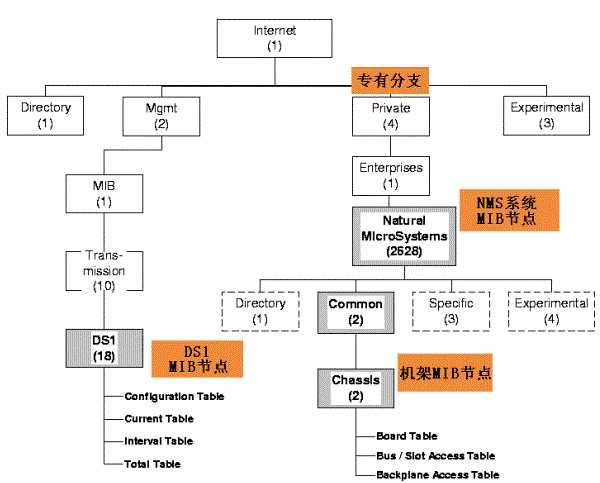
上图中的节点是从internet开始的,其实上面还有几个节点请看下图。
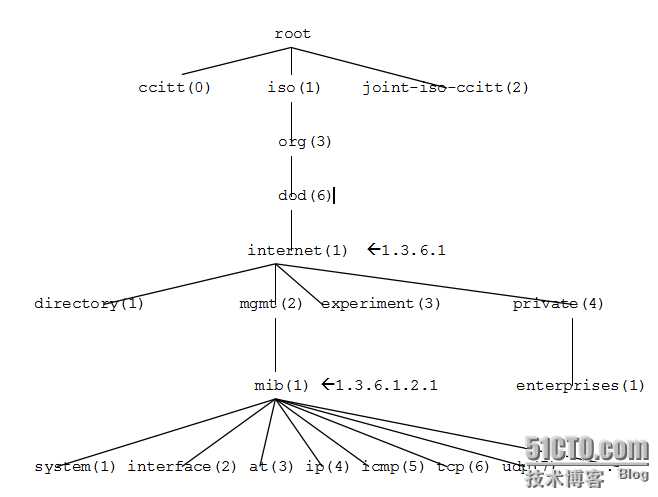
下图给出了对一个DS1线路状态进行查询的OID设置例子。

2.SNMP消息类型
SNMP中定义了五种消息类型:Get-Request、Get-Response、Get-Next-Request、Set-Request、Trap
- Get-Request 、Get-Next-Request与Get-Response
SNMP 管理站用Get-Request消息从拥有SNMP代理的网络设备中检索信息,而SNMP代理则用Get-Response消息响应。Get- Next-Request用于和Get-Request组合起来查询特定的表对象中的列元素。如:首先通过下面的原语获得所要查询的设备的接口数:
{iso org(3) dod(6) internet(1) mgmt(2) mib(1) interfaces(2) ifNumber(2)}
后再通过下面的原语,进行查询(其中第一次用Get-Request,其后用Get-Next-Request):
{iso org(3) dod(6) internet(1) mgmt(2) mib(1) interfaces(2) ifTable(2)} - Set-Request
SNMP管理站用Set-Request 可以对网络设备进行远程配置(包括设备名、设备属性、删除设备或使某一个设备属性有效/无效等)。 - Trap
SNMP代理使用Trap向SNMP管理站发送非请求消息,一般用于描述某一事件的发生。
3.SNMP管理信息库MIB
管 理信息库MIB指明了网络元素所维持的变量(即能够被管理进程查询和设置的信息)。MIB给出了一个网络中所有可能的被管理对象的集合的数据结构。 SNMP的管理信息库采用和域名系统DNS相似的树型结构,它的根在最上面,根没有名字。下图画的是管理信息库的一部分,它又称为对象命名 (objectnamingtree)。
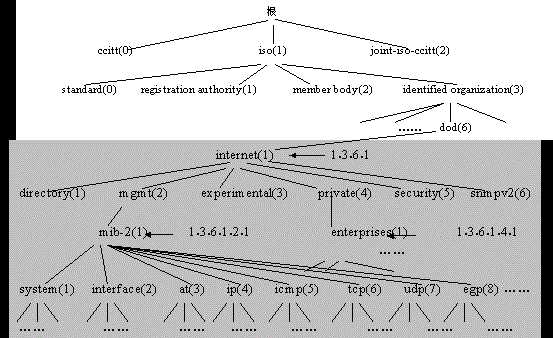
管理信息库的对象命名举例,对象命名树的 顶级对象有三个,即ISO、ITU-T和这两个组织的联合体。在ISO的下面有4个结点,其中的一个(标号3)是被标识的组织。在其下面有一个美国国防部 (Department of Defense)的子树(标号是6),再下面就是Internet(标号是1)。在只讨论Internet中的对象时,可只画出Internet以下的子 树(图中带阴影的虚线方框),并在Internet结点旁边标注上{1.3.6.1}即可。在Internet结点下面的第二个结点是mgmt(管理), 标号是2。再下面是管理信息库,原先的结点名是mib。1991年定义了新的版本MIB- II,故结点名现改为mib-2,其标识为{1.3.6.1.2.1},或{Internet(1) .2.1}。这种标识为对象标识符。最初的结点mib将其所管理的信息分为8个类别,见下图,现在mib-2所包含的信息类别已超过40个。
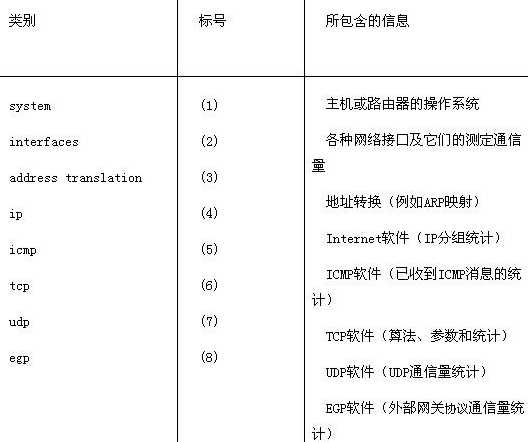
应当指出,MIB的定义与具体的网 络管理协议无关,这对于厂商和用户都有利。厂商可以在产品(如路由器)中包含SNMP代理软件,并保证在定义新的MIB项目后该软件仍遵守标准。用户可以 使用同一网络管理客户软件来管理具有不同版本的MIB的多个路由器。当然,一个没有新的MIB项目的路由器不能提供这些项目的信息。
这 里要提一下MIB中的对象{1.3.6.1.4.1},即enterprises(企业),其所属结点数已超过3000。例如IBM为 11.3.6.1.4.1.2},Cisco为{1.3.6.1.4.1.9},Novell为{1.3.6.1.4.1.23}等。世界上任何一个公 司、学校只要用电子邮件发往[email protected]进行申请即可获得一个结点名。这样各厂家就可以定义自己的产品的被管理对象名,使它能用 SNMP进行管理。
一 SNMP协议介绍
简单网络管理协议(SNMP:Simple Network Management Protocol)是由互联网工程任务组(IETF:Internet Engineering Task Force)定义的一套网络管理协议。该协议基于简单网关监视协议(SGMP:Simple Gateway Monitor Protocol)。利用SNMP,一个管理工作站可以远程管理所有支持这种协议的网络设备,包括监视网络状态、修改网络设备配置、接收网络事件警告等。虽然SNMP开始是面向基于IP的网络管理,但作为一个工业标准也被成功用于电话网络管理。
1. SNMP基本原理
SNMP采用了Client/Server模型的特殊形式:代理/管理站模型。对网络的管理与维护是通过管理工作站与SNMP代理间的交互工作完成的。每个SNMP从代理负责回答SNMP管理工作站(主代理)关于MIB定义信息的各种查询。下图10是NMS公司网络产品中SNMP协议的实现模型。
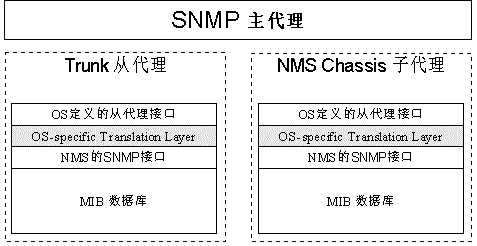
图10
SNMP代理和管理站通过SNMP协议中的标准消息进行通信,每个消息都是一个单独的数据报。SNMP使用UDP(用户数据报协议)作为第四层协议(传输协议),进行无连接操作。SNMP消息报文包含两个部分:SNMP报头和协议数据单元PDU。数据报结构如下图11。

图11
- 版本识别符(version identifier):确保SNMP代理使用相同的协议,每个SNMP代理都直接抛弃与自己协议版本不同的数据报。
- 团体名(Community Name):用于SNMP从代理对SNMP管理站进行认证;如果网络配置成要求验证时,SNMP从代理将对团体名和管理站的IP地址进行认证,如果失败,SNMP从代理将向管理站发送一个认证失败的Trap消息(见后);
- 协议数据单元(PDU):其中PDU指明了SNMP的消息类型及其相关参数。
2. 管理信息库MIB
IETF规定的管理信息库MIB(由中定义了可访问的网络设备及其属性,由对象识别符(OID:Object Identifier)唯一指定。MIB是一个树形结构,SNMP协议消息通过遍历MIB树形目录中的节点来访问网络中的设备。
下图给出了NMS系统中SNMP可访问网络设备的对象识别树(OID:Object Identifier)结构。
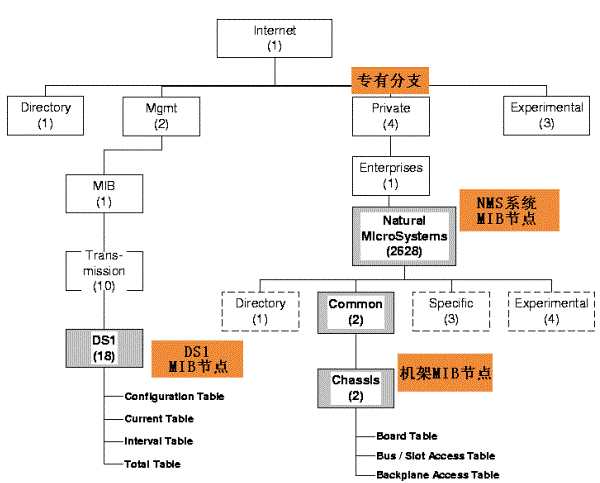
图12
下图13给出了对一个DS1线路状态进行查询的OID设置例子。

图13
图14中左图给出了RFC2495对DS1/E1中继线的MIB信息树图,右图是NMS系统中对机架Chassis管理MIB约定。
图14
3. SNMP的五种消息类型
SNMP中定义了五种消息类型:Get-Request、Get-Response、Get-Next-Request、Set-Request、Trap。
- Get-Request 、Get-Next-Request与Get-Response
SNMP管理站用Get-Request消息从拥有SNMP代理的网络设备中检索信息,而SNMP代理则用Get-Response消息响应。Get-Next-Request用于和Get-Request组合起来查询特定的表对象中的列元素。如:
首先通过下面的原语获得所要查询的设备的接口数:
{iso org(3) dod(6) internet(1) mgmt(2) mib(1) interfaces(2) ifNumber(2)}
然后再通过下面的原语,进行查询(其中第一次用Get-Request,其后用Get-Next-Request):
{iso org(3) dod(6) internet(1) mgmt(2) mib(1) interfaces(2) ifTable(2)}
- Set-Request
SNMP管理站用Set-Request 可以对网络设备进行远程配置(包括设备名、设备属性、删除设备或使某一个设备属性有效/无效等)。
- Trap
SNMP代理使用Trap向SNMP管理站发送非请求消息,一般用于描述某一事件的发生。
二 NMS产品中的SNMP从代理
NMS产品系统中SNMP管理模型中的各种组件及相互关系如图15所示。
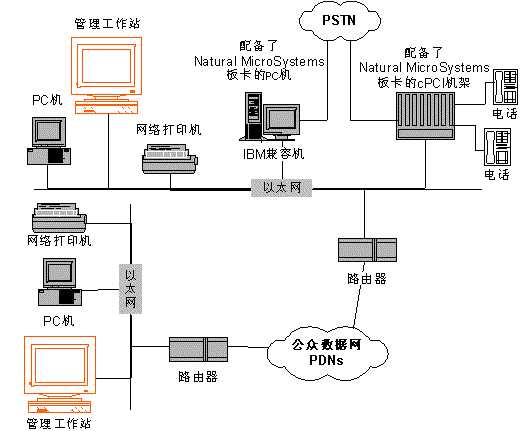
图15
图16给出了NMS产品的SNMP代理和MIB关系。
NMS产品的CT Access 4.02提供了各种SNMP代理,包括机架管理(Chassis Proprietary)、中继线Trunk配置(RFC2495)、软件修正改版(Software Revision)、OAM数据库维护等。

图16
下图17是SNMP测试的一个输出样本:

图17
参考资料
“TMN知识介绍” http://www.dset.com.cn/
NMS SNMP 参考手册:
http://www.nmscommunications.com/manuals/6744-13/chap1.htm
RFC 2570 互联网网络管理框架第三版
http://www.ietf.org/rfc/rfc2570.txt
Solstice Enterprise Agents 1.0 用户手册:
http://www.sun.com/software/entagents/index.html
DS1/E1/DS2/E2接口类型定义
http://www.ietf.org/rfc/rfc2495.txt
当前,定义了三个版本的网络管理协议,SNMP v1,SNMP v2,SNMP v3。SNMP v1,v2有很多共同的特征,SNMP v3 在先前的版本地基础上增加了安全和远程配置能力 。为了解决不同版本的兼容性问题,RFC3584定义了共存策略。
SNMP v1 是最初实施SNMP协议。SNMPv1 运行在像UDP,IP,OSI无连接网络服务(CLNS),DDP(AppTalk Datagram-Delivery),IPX(Novell Internet Packet Exchange)之上.SNMPv1 广泛使用成为因特网上实际的网络管理协议。
SNMP 是一种简单的request/response协议。网络管理系统发出一个请求,被管理设备返回相应。这些行为由四种协议操作组成:Get,GetNext,Set 和Trap。Get操作使用NMS来获取agent的一个或多个对象实例。如果agent返回get操作不能提供列表所有对象实例的值,就不能提供任何值。GetNext 操作是NMS用来从agent表中获取表中下一个对象实例。Set操作NMS用来设置agent对象实例的值。trap操作用于agent向NMS通告有意义的事件。
SNMP v2是1993年设计的,是v1版的演进版。Get,GetNext和Set操作相同于SNMPv1。然而,SNMPv2 增加和加强了一些协议操作。在SNMPv2中,如果再get-request中需要多个请求值,如果有一个不存在,请求照样会被正常执行。而在SNMPv1种将响应一个错误消息。在 v1,Trap 消息和其他几个操作消息的PDU不同。v2版本简化了trap消息,使trap和其他的get和set消息格式相同。
SNMPv2还定义了两个新的协议操作:GetBulk和Inform。GetBulk 操作被用于NMS高效的获取大量的块数据,如表中一行中的多行(一个UDP数据包应答)。GetBulk 将请求返回的响应消息尽量多的返回。Inform操作允许一个NMS 来发送trap消息给其他的NMS,再接收响应。在SNMPv2
,如果agent响应GetBulk操作不能提供list中全部的变量的值,则提供部分的结果。
SNMP v2在安全策略演变时存在多个变种,实际存在多个SNMP v2的消息格式。SNMPv2各个变种之间的不同在于安全的实施。因而各个SNMP v2变种之间的PDU都有相同的格式,而总的消息格式又都不同。
现在,SNMP v3 在前面的版本上增加了安全能力和远程配置能力,SNMPv3结构为消息安全和VACM(View-based Access Control Model)引入了USM(User-based Security Model)。这个结构支持同时使用不同的安全机制,接入控制,消息处理模型。SNMP v3 也引入使用SNMP SET命令动态配置 SNMP agent而不失MIB对象代表agent配置。
这些动态配置支持能够增加,删除,修改和配置远程或本地实体。
有三个可能的安全级别: noAuthNoPriv, authNoPriv, 和 authPriv.
noAuthNoPriv 级别指明了没有认证或私密性被执行.
authNoPriv 级别指明了认证被执行但没有私密性被执行.
authPriv 级别指明了认证和私密性都被执行.
auth---认证 支持MD5 or SHA;
priv---加密 支持DES or RSA;
通用的SNMPv3消息格式遵循相同的消息封装格式包含一个头和一个被封装PDU。 头部区域,被分成两个部分,一部分处理安全,和另外一部份与安全无关的部分。与安全无关部分所有的SNMPv3部分是相同的,而使用安全相关部分被设计成各种的SNMPv3安全模型,被SNMP内的安全模型处理。
SNMPv1只使用一种安全策略,团体名。团体名和密码相似。Agent能够被设置回答那些团体名能够被接受的Manager的查询。在很容易让人截取得到团体名或密码。SNMPv2增加了不少额外的安全。首先所有的包信息除了目的地址,其他都被加密。在加密的数据中包括团体名和源IP地址。Agent 能够解开加密包并使用收到的团体名和源IP地址使请求有效。SNMPv3提供三重的安全机制。最高层是认证和私密。中间层提供认证而没有私密和底层没有任何的认证机制和私密
SNMPV1,V2均采用明文传送,SNMPV3采用加密传送,也就是说对应SNMPV1,V2用抓包工具能在数据包中直接看到团体名。
如下团体名为:snmpv2, 显然抓包可以抓到
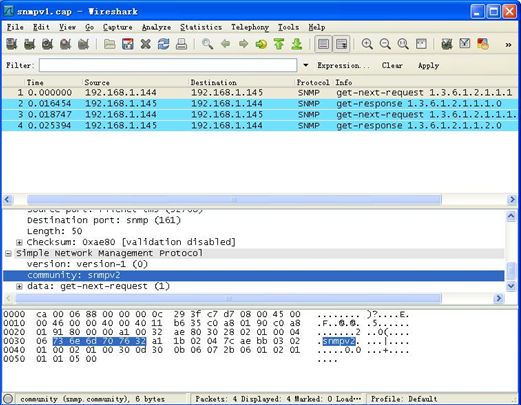
以上是关于SNMP协议介绍的主要内容,如果未能解决你的问题,请参考以下文章
snmp trap 与snmp相关介绍安装命令以及Trap的发送与接收java实现
Zabbix实战之部署篇Zabbix使用SNMP监控Linux系统
